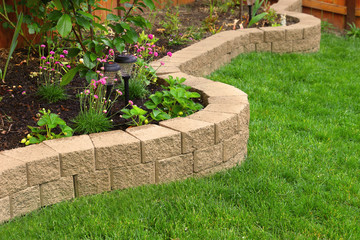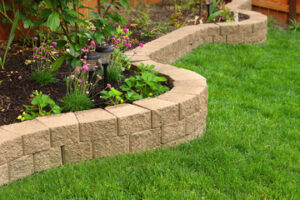Landscaping Fayetteville AR is the art of changing and improving outdoor areas. It encompasses much more than gardening and includes elements like trees, paths, patios and decorative stone work.
Consider a sustainable landscape that adapts to the natural climate patterns of your area. This reduces watering needs and constant lawn care, lowering utility bills.
Landscaping is the art of arranging outdoor elements to achieve a desired aesthetic effect. This can include the use of color, texture, form and line to create a balanced and harmonious design. A well-designed landscape can also serve practical purposes, such as reducing soil erosion, enhancing privacy, providing shelter for wildlife and reducing energy costs by shading homes and walls. The concept of landscaping has existed since ancient times, when civilizations first began modifying the natural environment for recreational and agricultural uses.
The most visible element of a landscape is color, but other aspects such as form, texture and line can also add interest and depth to the design. Choosing a palette based on a color wheel can help you create a unified look. Consider the time of day your landscape will be used when making color choices, as bright sunlight can make some colors appear more saturated and intense than others.
Texture can be created by contrasting the textures of different plants, or by using different surfaces such as rough versus smooth. The use of linear lines can also add texture to a landscape, by creating rhythm or movement. Lines can be structural and forceful, creating a formal character and leading the eye directly to a focal point, or they can be more organic and flowing, evoking a sense of nature and asymmetry.
Unity in a landscape is achieved through the blending of similar characteristics and the repetition of elements to create a unified whole. For example, the use of a particular type of stone in pathways, garden edging and retaining walls can establish visual ties throughout the landscape.
A landscape should evoke positive and pleasurable emotions in humans. This is achieved through the design process, which starts with identifying desired emotions and then designing a landscape to create those feelings. This is the defining characteristic of landscape design and distinguishes it from gardening, which begins with desired plants and flowers and then designs the surrounding space around them. This explains why gardens often feel disjointed and lack the cohesiveness of a designed landscape.
Function
Landscaping is both aesthetic and functional, raising property value and making outdoor spaces usable. It also benefits the environment by reducing soil erosion, improving air quality, and providing food and shelter for wildlife. It can even save on energy costs by shading windows and walls. Landscapers offer a variety of services, from planning and design to construction of outdoor features.
Plants are a fundamental aspect of landscape design, ranging from shrubs and trees to flower beds and turfgrass. The color, shape, and texture of these plants create depth and interest in a garden. Water structures like ponds, streams, and waterfalls add movement and sound to the landscape. Ornamental elements like lanterns, pagodas, and statues add visual intrigue and can have spiritual significance. The arrangement of these plants, as well as the colors and textures of hardscape features like walkways, patios, and decks, create a balanced design.
Landscapes can be designed in a variety of styles, from natural landscapes with native plants to formal designs with trimmed hedges. They can be designed to serve specific purposes, such as erosion control or privacy screening. They can even be designed to promote health by incorporating medicinal plants and providing shade for outdoor recreation.
The function of landscaping is augmented by the use of hardscape features, which are non-plant elements such as pathways, decks, and outdoor fireplaces. They create a sense of enclosure and create focal points within the garden. They can also be used to provide a contrast to the softness of the plantings by adding height and texture. Hardscape features can be constructed from a variety of materials, such as stone, wood, concrete, or brick.
While landscaping is primarily about creating a beautiful outdoor space, it can also serve practical purposes. For example, a well-planned garden can improve air quality by reducing pollution and improving visibility. It can also reduce noise and increase energy efficiency by shading windows and walls. Additionally, well-planned gardens can also promote health by boosting the immune system and providing physical and psychological benefits.
Maintenance
Landscaping is not a one-time event, but an ongoing process that requires periodic maintenance to ensure the beauty and functionality of your property. Landscaping maintenance includes taking care of plants, trees, flowers and greenery according to the needs of each season. In addition, it also involves incorporating elements like water features, rock gardens and outdoor structures to create visual interest and enhance the overall aesthetic. A landscape designer will help you determine what types of maintenance your garden or yard needs, and will recommend the best seasonal upkeep services to ensure that your space is beautiful and healthy year-round.
A well-maintained landscape can add value to your home or business, as it can make a great first impression on guests and potential customers. It can also increase the efficiency and safety of your building by creating a safe environment to walk through. It is important to choose a landscape design that matches the style of your property, so it looks cohesive and well-kept. Whether you are looking to add a bit of formality with trimmed hedges or a more natural look with wildflowers and flowing plant beds, Bland has the experience to get your project done right.
Maintenance is often referred to as “lawn care,” which encompasses mowing, fertilization, weed control and other upkeep services. An experienced landscaping service provider will understand the specific climate of your region and choose plantlife that will thrive in your area. They will also regularly prune and trim your greenery to prevent overgrowth and maintain a balanced appearance. In addition, they will provide seasonal color with annuals and perennials for a vibrant display each season.
Landscaping services are also used for more significant projects, such as altering the terrain of an outdoor space. This may include leveling or sloping the ground to improve drainage, visibility and usability. It can also involve installing walls, patios, driveways and other hardscapes to complement and blend with the surrounding environment.
A professionally-installed and maintained landscape can increase the value of your home or commercial property. It can also increase the efficiency and safety for your employees and customers. By utilizing the 4 essential parts of landscape design – hardscape for structure, softscape for color and texture, water features for visual appeal and serenity and lighting to highlight your landscape and hardscape features, you can achieve the perfect outdoor environment for your unique needs.
Environment
Landscaping has been changing the natural environment around homes for centuries. Initially this was done with little consideration to the environment, however there is now a push towards more sustainable landscaping practices. This includes the use of native plants, organic fertilizers and a minimal need for external inputs such as water, pesticides or chemical fertilizers.
The benefits of using sustainable plant species include providing food and shelter for local wildlife, which promotes a healthy ecosystem. Choosing to work with a landscaper who follows eco-friendly techniques also minimizes the need for chemical fertilizers and insecticides, making your yard a safer place for children and pets. Using mulches and compost, which improve soil health, can reduce the need for fertilizers as well. Another environmental benefit is conserving energy. Trees provide shade and help to cool the atmosphere, which can reduce air conditioning costs during hot summer months. Shrubs and trellises can also help to reduce energy costs by blocking out harsh sunlight and glare.
Creating a more sustainable landscape also helps to manage the flow of water throughout your property. Incorporating permeable materials, like gravel and stone, in your garden beds can reduce the amount of water that is absorbed by the soil and runoff into local rivers and lakes. Reducing the amount of turf grass in your yard is a great way to save water and reduce the nutrient runoff into bodies of water as well.
Many different plants can be used to create a sustainable landscape, including both perennials and annuals. These types of plants can be planted in odd numbers so that they eventually grow into a pattern of repeating shapes, which will give your yard a more cohesive look. Another trick to sustainable landscaping is to plant trees and shrubs in groups of three or five. This will help them mature faster, which will reduce the need for trimming and pruning.
When working with a landscaper to make your home more sustainable, it is important to be clear on what your goals are for the area you want to work on. You should know how much maintenance you want to do, what style of landscaping you prefer and if you would like to incorporate any hardscape projects into the design.


